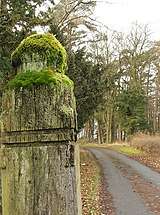Newton Hall, Northumberland
Newton Hall is an 18th-century country house at Newton on the Moor, near Alnwick, Northumberland, England. It is a Grade II listed building.[1]
- Not to be confused with the village and former parish of Newton Hall, also in Northumberland, which is now part of Bywell.
- See also: Newton Hall (disambiguation).

History
The house was built for Samuel Cook on the site of an earlier house in 1772 [1], possibly by Newcastle architect William Newton. His grandson Samuel Edward Cook inherited the estate and also the Hauxley estate of his maternal grandmother Frances Widdrington.[2] In 1840 he changed his name to Widdrington. He served as High Sheriff of Northumberland in 1854.
His nephew and heir Shalcross Fitzherbert Jacson [2](who changed his name to Widdrington in 1856) significantly remodelled and enlarged the house in 1864.[1] He was High Sheriff in 1874.
The Widdrington estates were broken up in the 20th century. Hauxley was sold in 1956 and Newton by auction in 1957.[3] The house contents were auctioned by Christie's in London on 20 January 2010.
The late 18th century stable block (also a Grade II listed building) bears a gateway clock made in 1763 for Princess Amelia a daughter of George II of England.[4]
References
- Historic England. "Newton Hall (1371158)". National Heritage List for England. Retrieved 28 October 2019.
- Burkes Genealogical and Heraldic Dictionary of the Landed Gentry of Great Britain and Ireland (1863) p1659 Google Books
- Remember When Northumberland Gazette 2 July 2007
- Historic England. "Newton Hall Stable Block (1155388)". National Heritage List for England. Retrieved 28 October 2019.